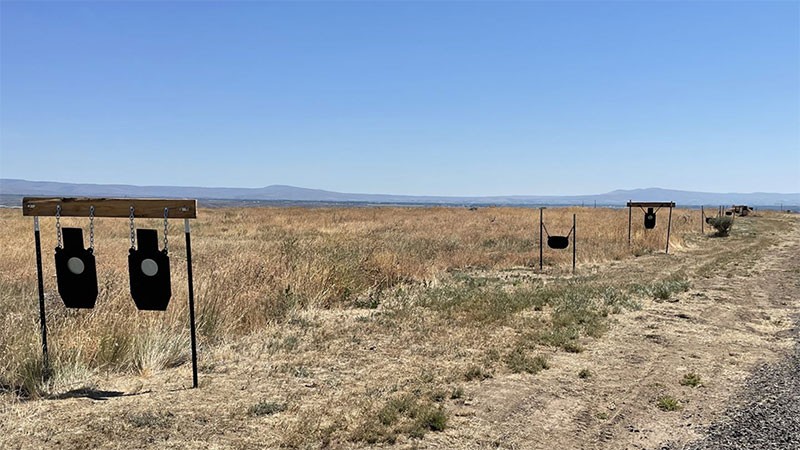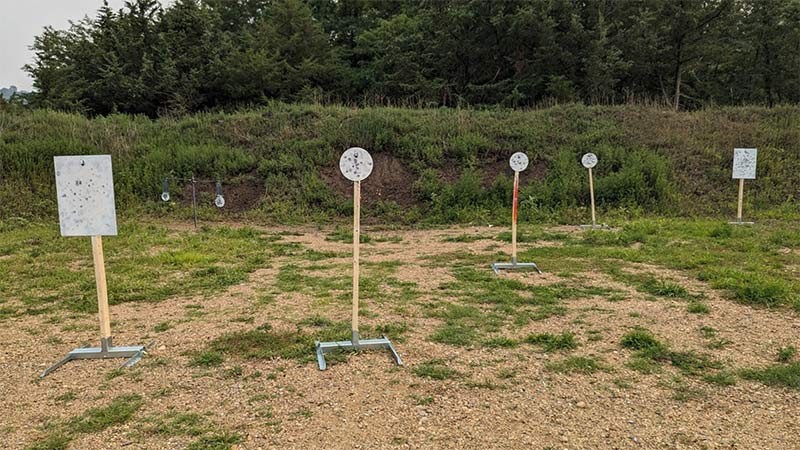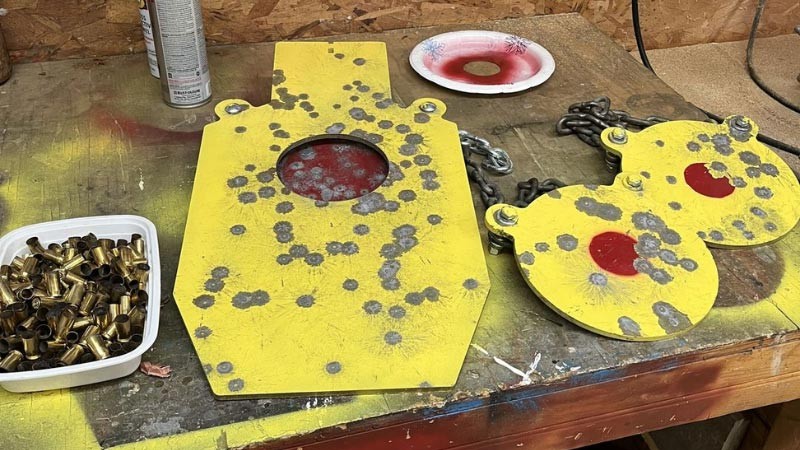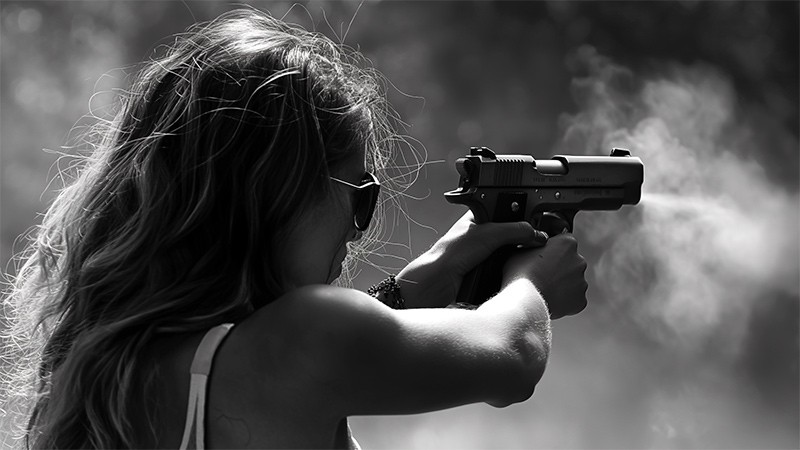
How Thick Should Steel Targets Be? Shooting Targets Selection & Steel Thickness Guide

Choosing the Right Thickness for Steel Targets: A Comprehensive Guide
When it comes to precision shooting, most enthusiasts know that high-quality steel targets are not just a matter of choice; they're a necessity. The question often arises, "how thick should my steel target be?"
In answering this question, one has to take into account several factors to ensure a reliable and safe shooting experience. The thickness of a steel target must correspond to the type of firearm you're using, as each varies in the force exerted upon impact.
Generally, handguns won’t need to use targets as thick as those intended for rifles due to the differing power and speed of the ammunition.
The simple answer is: the thicker, the better. However, this doesn't mean you have to go for the thickest plate available; this is because practicality and economics also play a critical role. For instance, shooters typically use steel plates ranging from 1/4" to 1/2" for handguns and between 3/8" to 1/2" for rifles.
But these guidelines aren't set in stone. The steel targets' thickness should, for example, be greater if you are engaging in long-range shooting, as the projectiles travel at high velocities and can cause more damage upon impact. Conversely, for shooting at closer ranges with lower-caliber guns, a thinner target may suffice.
To ensure safety and durability, it's worthwhile to invest in a target that's a bit thicker than what you might initially think is necessary. After all, targets that are too thin can develop pits, dents, or even dangerous deformations that could lead to ricochets.
As you grow in your shooting pursuits, having a steel target that can withstand repeated use without compromise is invaluable. In conclusion, selecting the right steel targets' thickness is not merely about meeting minimum standards; it's about enhancing your shooting practice through careful and informed selection.

Finding Elite Quality AR500 Steel Targets for Outdoor Shooting
For firearms enthusiasts who enjoy *outdoor* shooting, selecting the right *steel targets* can enhance both the safety and enjoyment of your sport.
Among the various materials used for *targets*, AR500 steel stands out as a leading choice due to its remarkable resilience and durability. The AR500 designation implies that the steel has been through a specific heat treatment process, making it capable of withstanding repeated impact without suffering significant damage.
Whether you're engaging in tactical training or honing your marksmanship, elite quality *AR500* steel targets provide a reliable and consistent challenge.
Opting for *AR500* **steel targets** means you'll be investing in a *shooting* experience where *targets* remain functional and maintain their shape shot after shot. This is crucial, as deformations in the surface can cause unpredictable ricochets, posing a risk to safety.
*AR500* targets sold by reputable manufacturers generally come in varying *thicknesses*—often ranging from 3/8" to 1/2" for handgun calibers and up to 3/4" for high-velocity rifle rounds. It's vital that you choose a *target* with sufficient thickness for the calibers you intend to use, following guidelines we previously discussed in "Choosing the Right Thickness for Steel Targets: A Comprehensive Guide."
When on the hunt for the best *steel targets* for your *outdoor* pursuits, emphasis should always be on quality. Not all AR500 steel is created equal, as the cut and finish of the *target* can affect its longevity and performance. For instance, targets with a smooth, even finish will aid in the predictability of bullet splatter patterns.
Additionally, consider the mounting solutions that accompany **AR500** *targets*, ensuring they provide stability and robustness for the most intense of shooting sessions. Lastly, remember that while the upfront cost of premium *AR500* steel *targets* might be higher, the long-term value comes from their extended lifespan and unwavering reliability—making them a cost-effective choice for serious marksmen.

Navigating the World of Steel Targets: AR400 vs AR500
When it comes to navigating the complex world of steel targets, shooters are often presented with a plethora of choices, each with its own set of benefits and considerations. Among the most popular materials used are AR400 and AR500 steel, both highly regarded for their durability and capability to withstand repeated rounds.
The choice between AR400 and AR500 often boils down to the type of shooting you'll be doing and the calibers involved. While AR400 is a sturdy option, often less expensive, it's typically suited for lower velocity rounds, making it a viable choice for pistol shooters or those engaging in less intense target shooting.
On the other side of the spectrum, AR500 steel targets represent the more premium end, favored for high-powered rifles due to its increased hardness and ability to endure the impact from faster, more powerful rounds.
When you're selecting steel targets, it's crucial to consider that thicker steel generally equates to improved longevity and safety; however, this also means a heavier and often more costly target.
Experts will recommend AR500 steel, which typically comes in 3/8" or 1/2" thicknesses, as a universal choice for its broad-spectrum resistance to various calibers and its ability to provide instant feedback with a resounding gong upon impact.
Both AR400 and AR500 steel targets offer considerable benefits but understanding the intended use and the expected frequency of shooting will better guide your decision. The nuances of vs can be subtle yet significant, with AR500 often being the superior choice for those seeking to invest in longevity and performance.
In any case, when you're out there trying to find elite quality for outdoor shooting, it's advisable to opt for targets that are suited to your shooting regimen, be it for tactical training or recreational purposes. As you delve further into the selection of the perfect steel thickness, remember that a well-informed choice will enhance your shooting experience with reliable and safe steel targets.

Static vs Gong Targets: Which Steel Target Type to Choose?
As an avid shooting enthusiast, understanding the nuances between static and gong steel targets is crucial for enhancing your shooting practice. While selecting the proper target thickness is important, as highlighted in "Choosing the Right Thickness for Steel Targets: A Comprehensive Guide," it's equally essential to choose the right type of target for your needs.
Static targets are the go-to choice for shooters looking for a steadfast option that stays in place after each shot, which can aid in consistent aim and precision. Gong targets, however, provide that satisfying audible feedback with each hit, swinging back and forth to confirm a successful shot.
When deciding whether to choose static or gong targets, consider the dynamic of your shooting sessions. Are you seeking immediate physical and auditory response to your accuracy, or do you need a stable target that will endure a day's worth of shooting?
Moreover, if you're building an outdoor shooting range, finding elite quality AR500 steel targets is imperative for both types of targets, as mentioned in "Finding Elite Quality AR500 Steel Targets for Outdoor Shooting." The durability of AR500 steel ensures that your targets withstand repeated gunfire, which is essential for both static and gong targets.
The choice between static and gong targets also involves safety considerations, as each type reacts differently upon impact. Static targets, being immovable, require an understanding of proper angle placement to minimize ricochet risks, whereas gong targets, with their movement, inherently direct bullet splatter in a more predictable downward path.
As you navigate the world of steel targets, you'll come across options like AR400 versus AR500, synonymous with "Navigating the World of Steel Targets: AR400 vs AR500," and it's important to choose a thickness compatible with the caliber you plan to shoot.
Ultimately, the decision on which target type to choose comes down to personal preference, your specific shooting applications, and safety protocols.

Ensuring Safety with the Appropriate Steel Thickness for Various Ammunition
When it comes to engaging in shooting activities, choosing the right steel targets is paramount in ensuring the safety of the shooter and bystanders. The appropriate thickness of the target is critical not just for durability, but it also affects how a bullet behaves upon impact, which can either contain or deflect dangerous fragments.
For various types of ammunition, different thicknesses of steel are recommended to optimize both safety and the longevity of the target.
Among the considerations for selecting the right thickness, the caliber and velocity of the round being fired are the most important factors. While a .22 caliber round may not necessitate an extremely thick plate, high-speed ammunition like a .308 or higher caliber rifle round will require a tougher, thicker steel target.
It's not just about stopping the bullet, but ensuring that the target can endure repeated hits without becoming pitted or warped over time.
The previous subtitles covered, such as "Choosing the Right Thickness for Steel Targets: A Comprehensive Guide" and "Finding Elite Quality AR500 Steel Targets for Outdoor Shooting," provide the context for understanding the necessity of selecting targets with an adequate resistance level.
Similarly, in "Navigating the World of Steel Targets: AR400 vs AR500", we discussed the differences in steel hardness and how AR500 steel is generally seen as a more durable option for heavy-duty use. Lastly, "Static vs Gong Targets: Which Steel Target Type to Choose?" highlights that the type of target also plays a role in determining the suitable thickness.
Ultimately, for a shooter to engage confidently and safely, there must be no doubt about the integrity of their steel targets. Regular inspection, proper maintenance, and an understanding of the fundamental relationship between ammunition type and steel quality are the cornerstones of ensuring safety and enhancing the shooting experience.
By adhering to these guidelines, enthusiasts can focus on their precision and enjoyment, knowing their steel targets are perfectly attuned to their various ammunition needs.

